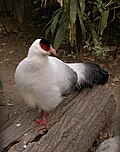Superregnum: Eukaryota
Regnum: Animalia
Subregnum: Eumetazoa
Cladus: Bilateria
Cladus: Nephrozoa
Superphylum: Deuterostomia
Phylum: Chordata
Cladus: Craniata
Subphylum: Vertebrata
Infraphylum: Gnathostomata
Superclassis: Tetrapoda
Cladus: Reptiliomorpha
Cladus: Amniota
Classis: Reptilia
Cladus: Eureptilia
Cladus: Romeriida
Subclassis: Diapsida
Cladus: Sauria
Infraclassis: Archosauromorpha
Cladus: Crurotarsi
Divisio: Archosauria
Subsectio: Ornithodira
Subtaxon: Dinosauromorpha
Cladus: Dinosauria
Ordo: Saurischia
Cladus: Theropoda
Cladus: Neotheropoda
Infraclassis: Aves
Cladus: Euavialae
Cladus: Avebrevicauda
Cladus: Pygostylia
Cladus: Ornithothoraces
Cladus: Euornithes
Cladus: Ornithuromorpha
Cladus: Ornithurae
Cladus: Carinatae
Parvclassis: Neornithes
Cohors: Neognathae
Cladus: Galloanseres
Ordo: Galliformes
Familia: Phasianidae
Subfamilia: Phasianinae
Genus: Crossoptilon
Species: C. auritum - C. crossoptilon - C. harmani - C. mantchuricum
Name
Crossoptilon Hodgson, 1838
References
The Journal of the Asiatic Society of Bengal 7 p. 864
Vernacular names
English: Eared Pheasant
Esperanto: Orfazano
español: Faisanes orejudos
suomi: Korvafasaanit
italiano: Fagiani orecchiuti
lietuvių: Ausuotieji fazanai
中文: 马鸡属
Eared pheasants are pheasants from the genus Crossoptilon in the family Phasianidae. Established by Brian Houghton Hodgson in 1838, the genus contains four species:[1]
Image Name Common name Distribution
| Image | Name | Common name | Distribution |
|---|---|---|---|
 |
Crossoptilon crossoptilon | White eared pheasant | China, Qinghai, Sichuan, Yunnan, and Tibet |
| Crossoptilon harmani | Tibetan eared pheasant | southeast Tibet and adjacent northern India | |
 |
Crossoptilon mantchuricum | Brown eared pheasant | northeastern China (Shanxi and nearby provinces) |
.jpg/120px-Pheasant_at_Sudeley_Castle_(5109).jpg) |
Crossoptilon auritum | Blue eared pheasant | central China |
The name Crossoptilon is a combination of the Greek words krossoi, meaning "fringe" and ptilon, meaning "feather"— a name Hodgson felt particularly applied to the white eared pheasant "distinguished amongst all its congeners by its ample fringe-like plumage, the dishevelled quality of which is communicated even to the central tail feathers".[2] All are large, sexually monomorphic and found in China.[3]
References
"ITIS Report: Crossoptilon". Integrated Taxonomic Information System. Retrieved 17 April 2015.
Jobling, James A. (2010). The Helm Dictionary of Scientific Names. London, UK: Christopher Helm. p. 123. ISBN 978-1-4081-2501-4.
McGowan, Phil; Madge, Steve (2010). Pheasants, Partridges & Grouse: Including buttonquails, sandgrouse and allies. London, UK: Christopher Helm. p. 312. ISBN 0-7136-3966-0.
Retrieved from "http://en.wikipedia.org/"
All text is available under the terms of the GNU Free Documentation License

